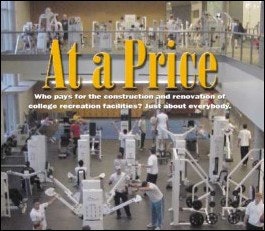Who pays for the construction and renovation of college recreation facilities? Just about everybody.

How much would you expect to pay for unlimited use of a $39 million, 159,155-square-foot recreation facility that boasts two large gymnasiums, an elevated 1.8-mile running track, the largest non-varsity collegiate cardiovascular and weight-training center in the country, four racquetball and two squash courts, a 25-yard lap pool and a 53-person spa?
But wait, therefs more. Members are also entitled to use of a relaxation center, a satellite nutrition clinic, a bistro, a spacious lounge with a fireplace and three multipurpose rooms for aerobics, martial arts, yoga and other classes. And thatfs not all. Sparkling with international flare, the lobby's slate floor was quarried in Holland and cut in India, and lobby and locker benches and finishes are crafted from Jarrah wood imported from Australia.
Now how much would you expect to pay for this high-end recreation and fitness package? If you're a student at Washington State University, you expect to pay-and do pay-$100 per semester.
"The students wanted something incredible," says Kathleen Hatch, interim director for university recreation and supervisor of the new WSU Student Recreation Center, which opened in January. "They wanted a 'wow factor' from the get-go. The students got what they asked for, but they're paying for it. We couldn't have pulled this off without that $100 fee, which is a lot for students to swallow. The good news is that their negative attitude toward the fee shrinks exponentially once they're in here."
When 63 percent of WSU students approved a mandatory $100 per semester fee in an April 1997 campus referendum, they saddled future generations of students with a financial burden some have no desire to bear. They also unwittingly involved faculty, staff, alumni and the community at large in a debate that's become increasingly common on college campuses facing debts from new or renovated recreation and fitness centers: Who should pay for what? And why?
"If students are in an uproar because they're paying for nothing, and getting very few recreation opportunities, they ought to be in an uproar," says Bill Canning, director of recreational sports at the University of Michigan and president of Centers LLC, a Washington, D.C.-based consulting firm specializing in college recreation facilities. "But if they're walking into a multimillion-dollar facility, there's some real added value and added quality of life brought to that campus community, and it has a cost."
Indeed, WSU's center must charge fees to all students carrying more than seven credits (even if they never set foot in the facility), as well as to faculty and staff, alumni, university associates, spouses and partners-not to mention the daily passes it sells to Pullman residents-simply to make debt-retirement payments. "Each category of membership has evolved more to generate revenue than to generate new members of the facility," Hatch says. Operational and staffing costs are barely covered by those fees, she adds, forcing the center to hire a marketing director, consider corporate sponsorships and create new in-house programs.
Fortunately, there's been little on-campus retaliation against the fees-at least so far. As senior Pamela Loughlin told Spokane's Spokesman-Review the day the center opened, "You walk in, and you just want to be healthy." Hatch expects most of WSU's 14,000 or so full-time students to eventually use the new Student Recreation Center, and she thinks faculty and staff members-who pay a discounted $300 annual rate, or $140 per semester and $70 in the summer-eventually will buy into the facility, too.
"Before we opened the center, they would have cried, 'Three hundred dollars? No way!' " she says. "Now, they've got smiles on their faces when they come in and can't believe how great this place is. There are some who came from Seattle, where health club memberships can cost $1,000 a year, and think they've died and gone to heaven. It's almost shameful how affordable this place is."
New and renovated recreation facilities on campuses large and small continue to enhance the lives of countless students, faculty and staff members. But college recreation centers, much like their patrons, come in all sizes and styles. Just as each facility is different, so too is the way in which each college or university approaches the fee issue.
Determining which students will be charged (full-time only, full-time and part-time, graduate students, extensioncenter students), how they will be assessed (hidden in tuition bills or spelled out in a line-item charge) and how much various other users will pay, is a huge and unique undertaking. It depends as much on the political nature of the institution as it does on fiscal responsibility.
Community memberships typically run the highest, followed by fees for faculty and staff. Student memberships almost always cost the least. That said, consider what faculty and staff at the University of Memphis did to protest what they considered unreasonable user fees. Following a strategy set forth by the UM Faculty Senate, some faculty members boycotted the renovated $8.8 million Student Recreation and Fitness Center after their annual membership fee tripled from $40 to $120.
That attitude simply doesn't fly with John Paine, director of recreational facilities at the University of Wisconsin, where students pay about $34 annually for use of four recreation facilities, while faculty and staff pay $78 per year for three facilities. What's more, up until the mid-'90s, faculty and staff were allowed free access to campus recreation opportunities. "If you come on our campus, you'll hear some of our faculty and staff-some of them-arguing about $78 and saying use of the facilities should be a benefit," Paine says. "Overall, the students on this campus, since the mid-'70s, have gotten a good deal. The faculty and staff, because they didn't pay for so many years, have gotten a better deal."
On some campuses, the use of outdated and overcrowded recreation facilities remains free for students, too. "We never checked IDs," says the recreation director at one small Midwestern university, when asked how his old facility operated. "We had townies in there, we had faculty and staff, we had students. It was basically an open building."
But other institutions assess per-semester student user fees typically ranging from the teens (the University of Michigan) to $100 and higher (Miami University of Ohio). Campus officials usually cite comparisons to other fitness options in the area as justification for their fees, which more often than not still fall short of what for-profit centers charge. They also consider the caliber of the facilities. Michigan's campus, for example, houses four indoor recreation facilities serving about 38,000 students, but the two newest facilities were built in 1976.
The oldest date back to the 1920s, when the nation's first facility dedicated exclusively to collegiate intramural sports was constructed. Overcrowding (Michigan's student weight room takes up only 8,000 square feet) and inefficient use of space (the Intramural Sports Building houses more than 1,000 lockers each for men and women) has led Canning to develop a five-year renovation plan that would, among other things, expand the weight area to 38,000 square feet and convert hundreds of lockers into space for cardiovascular equipment. If the renovation goes through, Canning says the university will need to revisit its user-fee structure, most likely leading to a marked increase from the current $15-per-semester rate.
When Tulane University opened the 150,000-square-foot Reily Center in 1989, university officials assessed a $75 user fee to students for several reasons. Chief among them was the institution's intention to operate the facility as a small business on campus and turn a profit, which it did within a few years, says Canning, who was involved in the project as Tulane's director of recreation. "That was absolutely a different type of entity for a college recreation facility," he says.
The Reily Center's controlled-access design influenced the blueprints of many future college-recreation facilities with its integrated-card activity-monitoring system, which limits all nonrecreation activity spaces-such as lobbies, classrooms, and building entrances and exits-to areas outside of a main control point. Such arrangements avoid the open-door policies of many older recreation facilities and allow only qualified users-paying patrons, if you will-access beyond a certain point. The added operation costs of that technology, coupled with the Reily Center being the first real recreation facility on the Tulane campus, resulted in the implementation of the mandatory fee.
"Let's get these types of facilities and programs established, but then let's be cognizant of the value they have within the marketplace and make them financially viable," Canning suggests. "The market is there; we just need to be aware of what that market is. It's changing."
You don't have to tell that to Bob Sinclair, director of university recreation at Ferris State University. A cramped barnstyle field house on campus used to provide space for athletic teams, physical education classes and recreational activities - but never at the same time. Consequently, recreation often got short shrift.
Student-government leaders spent the 1996-97 school year polling their 8,500 peers to determine whether students wanted a new recreation facility and how much they would pay to use it. Proposed fees ranged from $30 to $100 per semester. In the end, students settled on a $50-per-semester fee, and Ferris State officials agreed to renovate and add on to the old barn, which now houses 119,000 square feet of space dedicated exclusively to recreation.
The $7.6 million facility, which opened in two phases between October 1998 and January 1999, boasts four gyms, a 25-yard pool, two aerobics rooms, a climbing wall, an indoor track and almost 10,000 square feet of space for cardiovascular and strength equipment. The athletes have moved across campus to the Wink Arena sports complex, which was built in conjunction with the Student Recreation Center.
Student fees, as well as those for faculty and staff ($240 per year) and community members ($360 per year), go exclusively toward the facility's debt retirement, Sinclair says. "We're not feedriven," he explains. "We do have a budget. Whether that's going to be taken away from me later in life, I don't know. But the university understands that the students want this, that there is a need for this."
And the students, whether they realize it or not, show their gratitude. "They really care about this place," Sinclair says, adding that users go so far as to chastise fellow members for not wearing athletic shoes on gymnasium floors. "They feel it's theirs, and in essence, it is. We cater to them. Very rarely do we close down, even for classes. Some faculty members aren't wild about working out next to a class in progress, but they understand that this is a student recreation center, and that's who we built it for."
Try explaining that to for-profit health club owners, many of whom recruit students from campuses that lack elaborate recreation facilities and are "very successful" at it, according to one university's recreation director.
College and university officials who open their recreation facility's doors beyond the campus environment to the community at large must be aware of how that move could be perceived by for-profit businesses. Carefully structuring membership fees-even placing a cap on the number of community memberships sold-can help ease tensions that may arise from area clubs competing for a campus facility's members.
"We will not do anything to cross that line," explains Willie Stewart, facilities director at Loma Linda University & Medical Center's 100,000-square-foot Drayson Center, which sells memberships to everyone from students, alumni, faculty and staff to city employees, local residents, senior citizens and teenage dependents. "We've not marketed our memberships.
We don't do anything to get more people. And if the for-profits did complain, we'd back off in a second. We will not jeopardize our nonprofit status." While the university's 3,000 or so students pay about $70 per quarter to use the Drayson Center, the facility charges up to $375 a year for non-student memberships, something Stewart admits he has no problem doing, simply because the facility's goal is to provide recreation opportunities for the university's students - not the entire community. That said, about 30 percent of the facility's membership consists of Loma Linda residents and city employees. "We're not in the business of making money on anything we do here," Stewart says, offering a striking contrast to Tulane's approach. "All we want to do is make our budget, and if we do that, we're happy. But if we didn't have the community, we'd have to charge students more, or we'd have to shrink programming."
Drayson Center officials are so confident in their relationship with their offcampus neighbors that they're considering issuing a manual to help other institutions promote similar goodwill.
Perhaps the antithesis of Loma Linda's approach can be found on the other side of the country at the Harvard Business School. Shad Hall, opened in 1989, serves as a private fitness center exclusively for the HBS community-about 1,800 students, 800 faculty and staff members-who all pay a $100-per-year fee.
Countless executives in residence pay for the facility on a case-by-case basis. "No matter who you are on the Harvard Business School campus, the school's philosophy is that cost not be a prohibitive factor for using the facility," says Eileen Kassower, Shad's general manager and an employee of Town Sports International, a Manhattan-based firm that manages both Shad and the Malkin Athletic Center, Harvard University's student recreation facility located a few miles away. In an unusual arrangement, members of the HBS community and other Harvard campuses also are free to use the Malkin Athletic Center.
How does this exclusivity factor go over with the rest of the Harvard University community? Harvard officials prefer not to discuss the matter, leaving observers to draw their own conclusions. Student and university leaders at the University of Tennessee at Chattanooga - and other institutions around the country - are in the process of drawing their own conclusions about the need for a new recreation facility on campus, and how much students would pay to use one. The idea is not a new one, says Scott Black, president of UTC's Student Government Association, which is spearheading the effort to pass a student referendum this spring approving a new center. "This is something that has been looked at for the past two or three years," Black says. "It would build up steam and then fall on the back burner because something else came up."
The only recreation-related aspect of current expansion plans for the university involves widening the hallways where exercise equipment is currently located in Maclellan Gym. High on students' "want list" are an indoor track, a climbing wall, more cardiovascular and strength equipment and a swimming pool.
Surveys about the proposed new facility have been circulating on the 8,300-student campus since January, Black says, with $50 serving as the mandatory base fee. Even if a referendum mandating a new recreation center-which will likely include some wellness aspects, too - passes this spring, most students who voted for it won't be around to use it.
"I'm telling students to approach this with an open mind," Black says. "While we may not see the benefits, it will help future students, and it will make our degrees look better, because it makes the school look better." Indeed, most colleges and universities simply cannot survive on name and reputation alone these days. They need that "wow factor," the one Hatch says is so important to the recreation program at WSU. The presence of a beautiful recreation and fitness facility could be the make-or-break ingredient in a prospective student's decision about which institution to attend.
"You almost have to do this now to stay in business," Ferris State's Sinclair says. "When kids choose a school, they look at a lot of personal things now. They don't just base their decision on the name of the school and its academic programs. We built the recreation center more for the students who are here. But I think the university also looks at it as a great recruiting and retention tool. That's why I'm not too worried about where future funding is going to come from."




































